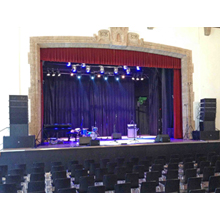 |
| On each side of stage double-18-inch Xsub is ground-stacked, with double-12-inch XS212 sub & XLD full-range elements stacked on top |
The Burghausen Jazz Week has been going strong for 46 years. During this time it has established itself as one of the world’s most important jazz festivals. This year, 7,500 fans attended concerts by Mario Biondi, Rebekka Bakken, Michael Wollny, and other stars. The audio production in the 600-seat City Hall—as well as in the more intimate jazz cellar—over the course of the week was the responsibility of MSE-Tontechnik GmbH of Malching. MSE boss Johannes Schilling relied on Electro-Voice sound reinforcement systems for the event—notably the compact XLVC line array—with great success.
Burghausen’s Jazz Week is as much part of the city as its world-famous castle. This year’s event, which ran from the middle to the end of March, was headlined by Mario Biondi, Rebekka Bakken, and Michael Wollny with support from numerous additional German and international stars. Malching-based MSE-Tontechnik was responsible for the sound reinforcement in the 600-seater City Hall, where MSE boss Johannes Schilling opted to deploy an Electro-Voice X-Line Very Compact (XLVC) line-array system. Overcoming several practical challenges with the venue, the customer, musicians, and fans were pleased with the result. “There were no flying points in the hall,” explains Schilling, “so we had to stack the main PA.” It was the same with the delay system: with nowhere to hang cabinets, the task of achieving homogeneous sound throughout the hall became far more difficult.
Fortunately, Schilling has the experience to come up with the ideal solution: on each side of the stage he ground-stacked a double-18-inch Xsub for the low frequencies, with a double-12-inch XS212 sub and five XLD full-range elements stacked on top. Two ZXA1 powered speakers served the central seats just below the stage. “We had originally planned to use four of them,” says Schilling, “but thanks to the 120-degree wide horizontal dispersion of the main array, no more than two near-field cabinets were needed.” The system was powered by six TG7 amplifiers equipped with RCM-26 DSP modules. These allowed the system to be controlled and supervised remotely using IRIS-Net software. The Dx46 FIR-Drive system processor handling the near field was also integrated into the IRIS-Net control network.
The result was consistent, powerful sound throughout the hall – to the delight of all present: “The organisers were completely satisfied with the sound,” reports Schilling. “I received praise from the performers, and fans also approached me to say how brilliant they thought the sound was.” All in all, a highly gratifying experience for Schilling and the rest of the MSE team!




